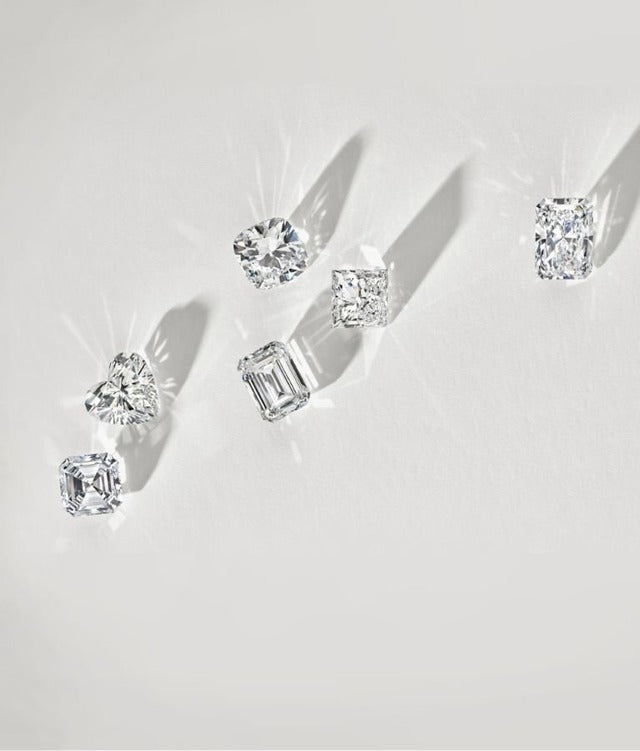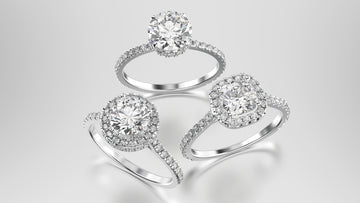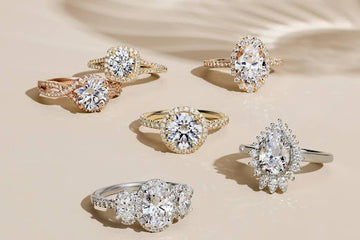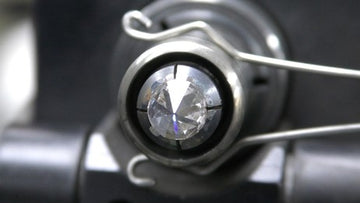

Lab Grown Diamonds
Lab grown diamonds are similar to their natural counterparts and can be a more affordable option. We are committed to going beyond industry standards to offer lab grown diamonds that are ethical and sustainable.

Diamond Certification
These certifications guarantee their quality and authenticity, instilling trust in consumers. With stringent standards upheld by reputable institutions, lab-grown diamonds undergo rigorous testing, affirming their ethical and sustainable origins. Consumers can confidently purchase these diamonds, knowing they meet industry benchmarks and are a responsible choice. This certification process reinforces the credibility of lab-grown diamonds in the market, fostering transparency and consumer confidence.

What Are Lab Grown Diamonds?
Lab-grown diamonds, also referred to as lab-created diamonds, man-made diamonds, engineered diamonds, and cultured diamonds, are produced in carefully controlled laboratories using advanced technological methods that replicate the natural conditions in which diamonds typically develop beneath the Earth's crust. These lab-created diamonds are composed of real carbon atoms organized in the distinctive crystal structure of diamonds. Because they share the same material as natural diamonds, they display identical optical and chemical properties.

How Are Lab Grown Diamonds Made?
Lab-grown diamonds stem from minuscule carbon seeds from existing diamonds. Using advanced techniques like High Pressure High Temperature (HPHT) or Chemical Vapor Deposition (CVD), scientists replicate natural diamond formation in controlled settings. After 6-10 weeks, raw diamonds are produced, later crafted into jewelry. Both HPHT and CVD methods yield diamonds indistinguishable from natural ones.

How to tell the difference?
Without specialized equipment, distinguishing between lab-grown and natural diamonds is impossible—they look identical. The sole disparity lies in their origins: one natural, the other cultivated in a lab. Our lab-grown diamonds possess identical physical, chemical, and optical characteristics, including fire and sparkle, differing only in formation method, trace elements, detectable solely through specialized tests.
How Are Lab Grown Diamonds Certified and Graded?
Lab-grown diamonds undergo certification just like natural diamonds. Trained gemologists from reputable institutions like the Gemological Institute of America (GIA) and the International Gemological Institute (IGI) evaluate the 4Cs (cut, colour, clarity, and carat grades) of each gemstone. After their assessment, they issue a detailed report, either in physical or digital form.
Design Your Own
Lab Grown Diamond FAQs
Why are lab grown diamonds more affordable than natural diamonds?
Lab grown diamonds are more affordable than natural diamonds primarily because of their production process. While natural diamonds have taken millions of years to form under extreme pressure and temperature deep within the Earth's crust, lab grown diamonds are created in a controlled environment using advanced technology that mimics the natural diamond-growing process. This significantly reduces the time and resources required for their formation, resulting in lower production costs and, subsequently, a more affordable price for consumers.
How much do lab grown diamonds cost?
The cost of lab grown diamonds can vary depending on factors such as size and quality. Generally, lab grown diamonds are priced less than natural diamonds of comparable quality.
How can you tell if a diamond is lab grown?
Distinguishing between lab grown and natural diamonds isn’t possible with the naked eye. However, gemologists can identify lab grown diamonds through various methods. Most lab grown diamonds exhibit certain features or "fingerprints" that differ from natural diamonds. One common technique to identify them is using specialized equipment like spectroscopy to view fluorescence patterns. Additionally, some lab grown diamonds may have tiny inclusions or growth patterns that are not typical in natural diamonds, providing further clues to their origin.
How can a jeweler tell if a diamond is lab grown?
Jewelers can tell if a diamond is lab grown through various gemological tests. They may use equipment like a DiamondView tester, which relies on a diamond's fluorescence properties, or conduct advanced spectroscopy to analyze the gem's composition and structure. Additionally, many jewelers work with accredited diamond grading labs who provide documentation, such as grading reports, confirming the origin of the diamond. By relying on scientific methods and credible sources, jewelers can confidently determine whether a diamond is natural or lab grown.
How do you clean lab created diamonds?
Cleaning lab grown diamonds is similar to cleaning natural diamonds. You can use warm soapy water and a soft brush to remove dirt and grime. Avoid using harsh chemicals or abrasive materials as they may damage the diamond or its setting. Regular cleaning helps maintain the diamond's brilliance and beauty.
How long do lab grown diamonds last?
Lab grown diamonds, like natural diamonds, are extremely durable and can last indefinitely with proper care. They are composed of carbon atoms arranged in a crystal lattice, making them resistant to wear and scratches. As long as they are well-maintained and properly cared for, lab grown diamonds will maintain their sparkle and appearance for generations.
Is a lab grown diamond a real diamond?
Lab created diamonds are diamonds, just like natural diamonds. The primary difference lies in their origin: lab created diamonds are grown in controlled environments, while natural diamonds form naturally in the Earth's mantle. Chemically and physically, They are chemically, physically, and optically identical to natural diamonds, with the same hardness, brilliance, and fire.
Will a diamond made in a lab get cloudy?
Lab grown diamonds, or man-made diamonds, do not inherently become cloudy. A cloudy appearance in diamonds, whether natural or lab grown, is usually caused by the presence of certain impurities or structural irregularities. High-quality lab grown diamonds are as clear and brilliant as natural diamonds.
Is there a difference between lab and synthetic diamonds?
No. The terms "lab grown diamonds" and "synthetic diamonds" are used interchangeably by the Gemological Institute of America (commonly referred to as the GIA).
Are lab diamonds flawless?
Lab grown diamonds, like natural diamonds, can have various clarity grades, ranging from flawless (no inclusions visible under 10x magnification) to included (inclusions visible to the naked eye). The presence of inclusions or imperfections can affect the clarity of a lab grown diamond, just like with natural diamonds. Higher quality lab grown diamonds with fewer inclusions are generally more valuable and sought after.
Are lab diamonds a good investment?
Most customers purchase a lab grown diamond as a symbol of love and commitment, not as an investment. As the technology required to create a lab grown diamond is still relatively new, they are not expected to appreciate over time.
Can lab diamonds be insured?
Yes, lab grown diamonds can be insured just like natural diamonds. Many insurance companies offer coverage for lab grown diamonds as part of standard jewelry insurance policies. To ensure proper coverage, obtain a grading report or certificate from a recognized gemological laboratory when purchasing a lab grown diamond and share it with your insurance provider.
Could lab diamonds test as moissanite?
A diamond may be mistakenly identified as a moissanite when using some diamond testers due to their similarity in electrical conductivity. Gemologists are trained to understand the irregularities of diamond testers on lab diamonds and can distinguish between the two gems due to their differing refractive properties, with moissanites being double refractive and diamonds being single refractive.
What does it mean if my lab diamond is treated?
Treated lab grown diamonds have undergone additional processes to improve their color or clarity. For example, some lab grown diamonds might be subjected to high-pressure, high-temperature (HPHT) treatments or undergo a process called annealing to enhance their appearance.
If lab diamonds are created in a lab, why aren’t they all perfect?
While lab grown diamonds are created under controlled conditions, it's important to remember that they still can have imperfections. Just like natural diamonds, lab grown diamonds can have variations in color, clarity, and other characteristics. Factors such as the specific growth method, the quality of the seed crystal, and environmental conditions during the growth process can all influence the final appearance of the diamond. As with any gemstone, selecting a lab grown diamond of higher quality will generally result in a more perfect and desirable stone.
Are lab diamonds becoming more popular?
Lab-grown diamonds are becoming more popular due to their ethical and sustainable appeal, affordability, advancements in technology, and quality. Consumers are increasingly drawn to these diamonds for their responsible sourcing, lower prices, and high-quality appearance, leading to a shifting trend in the diamond market. While natural diamonds remain valuable, the rising popularity of lab-grown diamonds reflects a growing interest in sustainable and accessible options among consumers.
How long does it take to make a lab grown diamond?
Lab diamonds take between six and ten weeks to fully develop compared to the 1 to 3 million years for natural diamonds.



